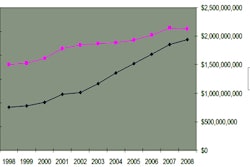Individuals diagnosed with cancer are at least 2.5 times more likely to declare bankruptcy than those without cancer, according to a study of patients in Washington state published online May 15 in Health Affairs.
Researchers from the Fred Hutchinson Cancer Research Center in Seattle found that 0.52% of cancer patients filed for bankruptcy within one year of diagnosis, compared with 0.16% of a control group without cancer. Cancer patients had a 1.7% bankruptcy rate within five years following diagnosis, while the control group had a rate of 0.7%.
In addition, younger cancer patients had bankruptcy rates that were two to five times higher than those of older patients, they found. The youngest age groups had up to 10 times the bankruptcy rate when compared with older patients (Health Affairs, May 15, 2013).
Most cancer patients older than age 65 have Medicare insurance and Social Security benefits, which could help mitigate the risk of bankruptcy for this group, according to the researchers.
Internist and health economist Dr. Scott Ramsey, PhD, and colleagues analyzed data from a population-wide registry of individuals older than 21 who lived in western Washington state and had received a cancer diagnosis between 1995 and 2010. They were compared with a randomly sampled cancer-free population matched by age, sex, and ZIP code.
Both groups were matched with records from the U.S. Bankruptcy Court for the Western District of Washington. Only Chapter 7 and Chapter 13 bankruptcy filings were analyzed.
Incidence rates for bankruptcy at one year after diagnosis (per 1,000 person-years) were as follows: thyroid cancer, 9.3; lung cancer, 9.1; uterine cancer, 6.8; leukemia/lymphoma, 6.2; colorectal cancer, 5.9; melanoma and breast cancer, both 5.7; and prostate cancer, 3.7.
Thyroid cancer may be linked with the highest bankruptcy rate because the disease affects younger women more often than other cancers, according to Ramsey and colleagues. Younger women are more likely than men to live in single-income households, with lower wages, lower rates of employment, and less access to high-quality health insurance, they noted.



















